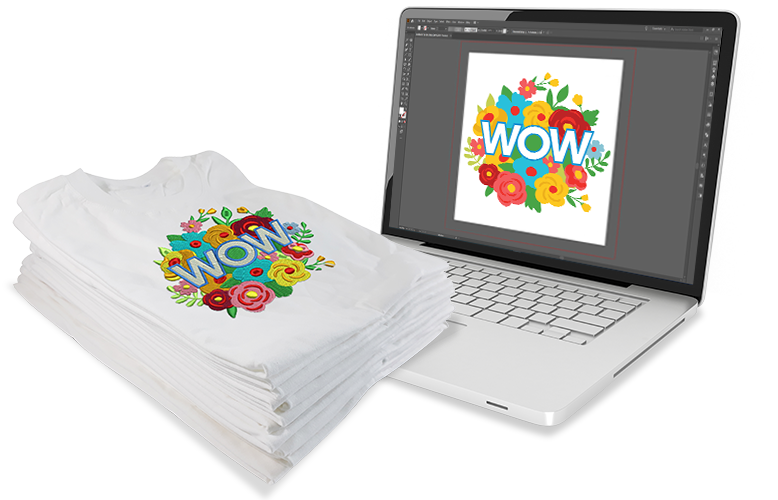Specialist Digitizing for Embroidery: Rapid and Reliable Solution
Wiki Article
Understanding the Embroidery Digitizing Process: Your Ultimate Overview
Needlework digitizing is a careful craft that needs accuracy and experience to convert intricate styles into electronic formats for machine needlework. As craftsmens get started on this journey to master the needlework digitizing procedure, an extensive understanding of the basics sets the foundation for excellence. However, beyond the simple understanding lies a world of advanced software, specialized devices, and nuanced methods waiting to be discovered. By diving right into the nuances of digitizing, one can open a globe of imaginative possibilities and elevate their embroidery tasks to brand-new elevations.
Recognizing Needlework Digitizing Essentials
Embroidery digitizing essentials create the foundation whereupon complex layouts are translated into machine-readable layouts for accurate stitching. This initial step in the embroidery digitizing procedure is crucial for guaranteeing that the final embroidered product is a faithful representation of the initial layout. Recognizing needlework digitizing fundamentals includes understanding essential concepts such as stitch kinds, sew instructions, density, padding, and draw settlement.Stitch types play a vital function in determining the aesthetic and textural result of the stitched layout. By picking the proper stitch kind, whether it be satin, fill, or running stitch, digitizers can attain the preferred result and improve the total high quality of the needlework. Furthermore, stitch direction influences the circulation and dimension of the design, while thickness figures out the spacing and insurance coverage of the stitches.
Moreover, rug stitching gives stability to the design by safeguarding the fabric and protecting against distortion throughout the embroidery process. Draw settlement is an additional vital factor to consider to counteract the all-natural propensity of material to agreement when stitched. Grasping these embroidery digitizing fundamentals is essential for creating professional-quality stitched items.
Choosing the Right Digitizing Software
Choosing the suitable digitizing software application is a crucial decision that substantially impacts the effectiveness and top quality of the needlework digitizing procedure. Digitizing for Embroidery. When choosing the best digitizing software application, it is necessary to think about variables such as the intricacy of layouts you prepare to develop, the user-friendliness of the software application, the degree of customer assistance provided, and the compatibility with your embroidery makerThere are numerous digitizing software program alternatives offered on the market, varying from basic programs for beginners to advanced software for professional digitizers. Some popular options include Wilcom EmbroideryStudio, Hatch Embroidery Software Program, and PulseID. These software use a vast array of tools and features to help you develop detailed styles with simplicity.
Before choosing, it is recommended to discover the various software program alternatives via free tests or trials Clicking Here to figure out which one finest fits your requirements. Additionally, reviewing testimonials and seeking recommendations from experienced digitizers can give useful insights right into the toughness and weaknesses of each software plan (Digitizing for Embroidery). By thoroughly examining your requirements and contrasting the functions of different digitizing software program, you can make an educated choice that improves your embroidery digitizing operations
Digitizing Tools and Techniques

Optimizing Layout Settings for Needlework
Grasping the complexities of style setups is fundamental in accomplishing ideal outcomes in the embroidery digitizing process, structure upon the foundation laid by comprehending digitizing devices and methods. When maximizing style settings for embroidery, it is important to think about elements such as stitch kind, thickness, underlay, pull settlement, and enrollment. Sew type option affects the overall appearance and feel of the layout, with options like satin, fill, and running stitches offering various textures and effects. Thickness describes the spacing and density of stitches, affecting the design's coverage and sturdiness. Appropriate underlay stitching supplies security and prevents fabric distortion, particularly for complicated layouts or on stretchy products. Draw settlement adjusts for hop over to these guys material stretch throughout sewing, making certain precise design replication. Registration settings straighten different components of the layout precisely, maintaining general style integrity. By fine-tuning these layout settings, embroiderers can boost the quality and accuracy of their stitched productions.
Troubleshooting Common Digitizing Issues
When coming across common digitizing concerns throughout the needlework procedure, it is important to recognize the origin and execute reliable services immediately. One common trouble is stitch thickness concerns, where stitches might be too thick, triggering the fabric to pucker, or too sporadic, bring about voids in the style. Readjusting the stitch thickness settings in the digitizing software program can aid resolve this problem.One more constant challenge is thread breaks during the embroidery process. This can take place due to various reasons such as incorrect tension settings, dull needles, or using low-grade string. Ensuring correct maintenance of the needlework maker, including normal needle modifications and stress changes, can minimize the incident of string breaks.
Furthermore, layout registration mistakes can cause misaligned elements within the needlework design. Examining the layout positioning in the digitizing software program and making required modifications before stitching hop over to here can help in preventing this issue. By resolving these common digitizing concerns immediately and successfully, you can ensure a smoother embroidery procedure and premium finished items.
Conclusion
In verdict, understanding the needlework digitizing procedure calls for a solid understanding of the fundamentals, the best option of software program, and knowledge of devices and strategies. Maximizing layout settings and fixing common digitizing issues are crucial action in guaranteeing high-grade needlework results. By following these actions diligently, one can achieve accuracy and efficiency in the digitizing procedure.Report this wiki page